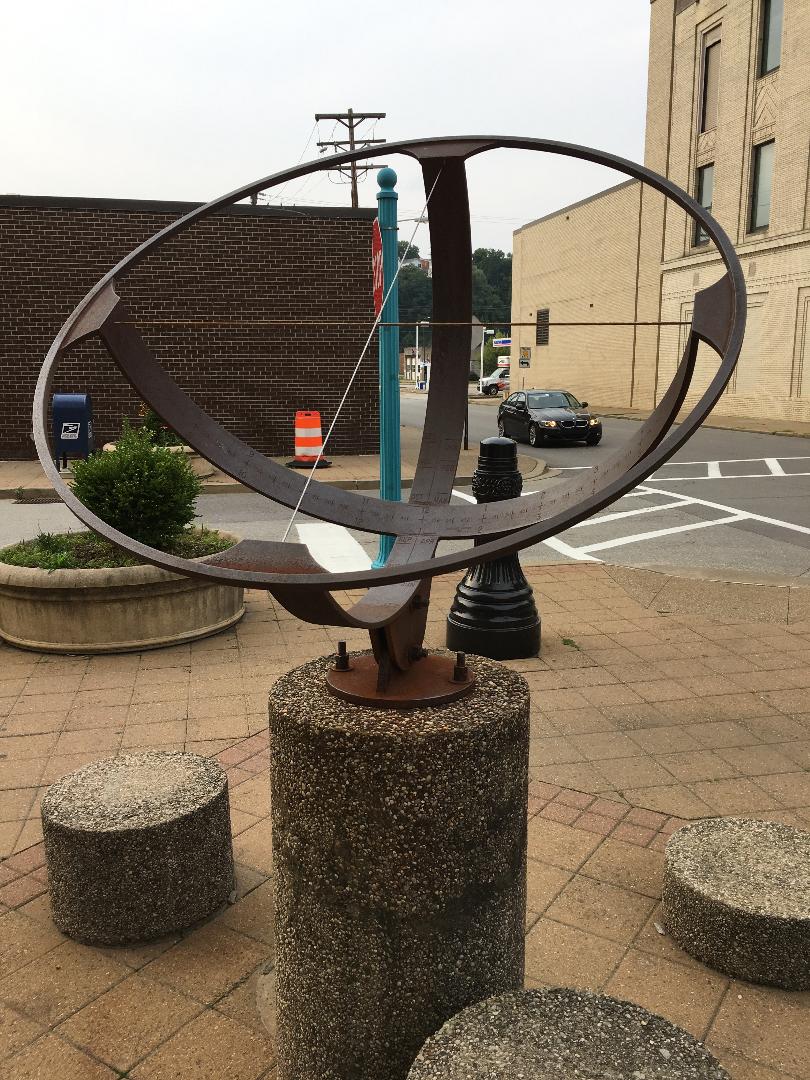
Photograph of an Open Armillary Sundial (which tells both time
and date) located at the northern tip of Library Park, near the center
of the Pittsburgh suburb of Carnegie, Pennsylvania; at the top of
Library Hill is the historic Andrew Carnegie Free Library and Music
Hall, the fourth (of only five) Carnegie libraries where both construction and endowment were funded by famous industrialist and philanthropist Andrew Carnegie. Telling time has come a long way since sundials were in use for determining the time-of-day. Now, a Quantum Watch can tell time using laser pulses.
(Image Source: Friends of the Zeiss; Photographer: Pittsburgh-Area Free-Lance Photographer Lynne S. Walsh)
By Glenn A. Walsh
Reporting for SpaceWatchtower
A completely new way to tell time has been developed by what scientists call a “Quantum Watch”.
Lead author of the published research and experimental physicist Marta Berholtz describes this as a Quantum Watch rather than a Quantum Clock, because a watch “provides time” while a clock requires keeping track of time. The scientific paper was published in the research journal, Physical Review Research.
Dr. Berholtz conducted this post-doctoral research, after moving to Uppsala University (Uppsala, .Sweden – the oldest university in Sweden), coming from Tartu University (Tartu, Estonia). She conducted the research during the COVID-19 Pandemic, when she had extra time to spend in a laser lab.
Most clocks depend on a mechanical or electronic beat to measure time, measuring the time between two intervals. From the tick of a traditional clock or wristwatch, to the swing of a pendulum in a grandfather clock, time is measured from one event to another event.
When dealing in Quantum Mechanics, traditional time measurement is not possible. In the new Quantum Watch there is no “time zero”. Time is determined by the evolution of a Quantum System of Rydberg Atoms. Rydberg Atoms, atoms where the electrons are in a special excited state, are then measured by laser pulses.
Time is reckoned in a Quantum Watch by determining how long a state of Rydberg Helium Atoms has lived, described as a “time fingerprint” which represents a specific time. Unlike optical atomic clocks which measure time, this is just a new way of detecting time, according to Johan Soderstrom of Uppsala University and co-author of the research paper.
The original experiment was not about trying to find a Quantum Watch. They were simply studying the dynamics of how very short laser bursts affect electrons. It was only after reviewing and analyzing the results where a surprising conclusion was the possibility of a Quantum Watch.
Practical applications for a Quantum Watch are unknown at this time. However, it could be useful in Quantum Computers.
Internet Links to Additional Information ---
More details on the Quantum Watch:
Link 1 >>> https://www.sciencealert.com/scientists-just-discovered-an-entirely-new-way-of-measuring-time
Link 3 >>> https://phys.org/news/2022-10-rydberg-states.html
Source: Glenn A. Walsh Reporting for SpaceWatchtower, a project of Friends of the Zeiss
Sunday, 2022 November 13.
Like This Post? Please Share!
More Astronomy & Science News - SpaceWatchtower Twitter Feed:
Link >>> https://twitter.com/spacewatchtower
Astronomy & Science Links: Link >>> http://buhlplanetarium.tripod.com/#sciencelinks
Want to receive SpaceWatchtower blog posts in your in-box ?
Send request to < spacewatchtower@planetarium.cc >.
gaw
Glenn
A. Walsh, Informal Science Educator & Communicator
(For more than 50 years! -
Since Monday Morning, 1972 June 12):
Link >>> http://buhlplanetarium2.tripod.com/weblog/spacewatchtower/gaw/
Electronic Mail: < gawalsh@planetarium.cc >
Project Director, Friends of the Zeiss: Link >>> http://buhlplanetarium.tripod.com/fotz/
SpaceWatchtower Editor / Author: Link >>> http://spacewatchtower.blogspot.com/
Formerly
Astronomical Observatory Coordinator & Planetarium Lecturer,
original Buhl Planetarium & Institute of Popular Science (a.k.a.
Buhl Science Center), America's fifth major planetarium and Pittsburgh's
science & technology museum from 1939 to 1991.
Formerly Trustee,
Andrew Carnegie Free Library and Music Hall, Pittsburgh suburb of
Carnegie, Pennsylvania, the fourth of only five libraries where both construction and endowment funded by famous industrialist & philanthropist Andrew Carnegie.
Author of History Web Sites on the Internet --
* Buhl Planetarium, Pittsburgh: Link >>> http://www.planetarium.cc Buhl Observatory: Link >>> http://spacewatchtower.blogspot.com/2016/11/75th-anniversary-americas-5th-public.html
* Adler Planetarium, Chicago: Link >>> http://adlerplanetarium.tripod.com
* Astronomer, Educator, Optician John A. Brashear: Link >>> http://johnbrashear.tripod.com
* Andrew Carnegie & Carnegie Libraries: Link >>> http://www.andrewcarnegie.cc
* Other Walsh-Authored Blog & Web-Sites: Link >>> https://buhlplanetarium.tripod.com/gawweb.html
No comments:
Post a Comment